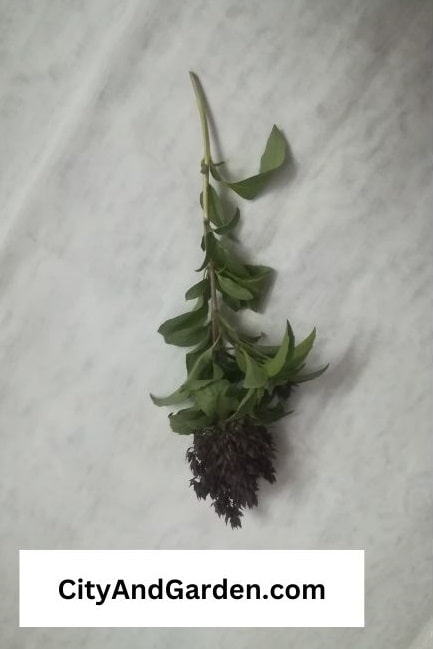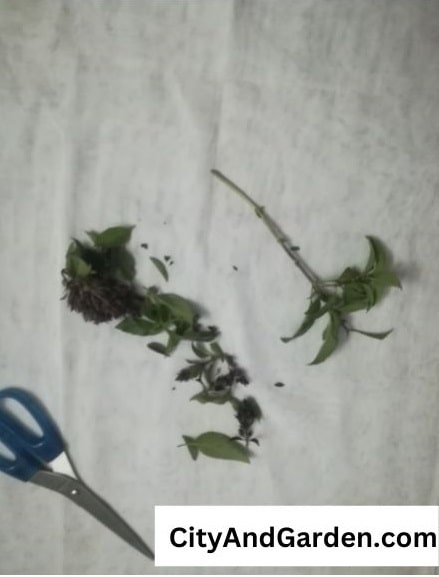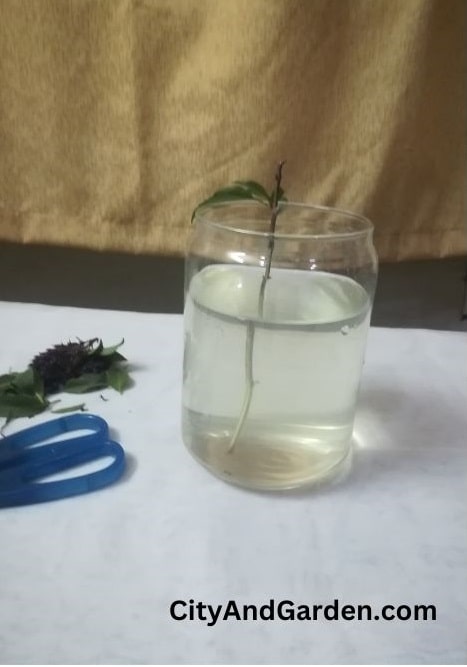Growing basil in water can give you a consistent supply all year round for different delicious cuisines. It is easy and fun. In this article, I will tell you the exact steps to grow your own basil in water. And more importantly, you will learn how to maintain it correctly.
Steps for growing basil in water from cutting
Choose a healthy stem: The first step for growing healthy basil hydroponically is to choose a healthy stem. A healthy stem will have all its leaves green and fresh.

Cut a 7 inches stem: Using sterilized and sharp scissors cut a healthy stem that is 7 inches in length.
Remove the lower leaves and flowers: Remove all the lower leaves sets and flowers If there are any. Leave only two leaf sets at the top of the stem. This is important because you want the stem to focus on developing new roots underwater instead of focusing on feeding the flowers and leaves.

Choose Clear water container: A transparent water container is perfect for growing your basil in water because it allows you to see the roots underwater when it grows.
Choose quality water: The type of water you choose for growing your basil hydroponically is an important factor for success. The best option you have is rainwater because it has a perfect pH level and is free from treated chemicals.
The second best option you have is distilled water. Avoid tap water as it contains harmful minerals, salts, and treated chemicals. But If it is your only option use it after you put it in an open container overnight for some treated chemicals to evaporate.
Place the cutting in the water: Place the basil cutting in the water in a way that only 2/3 of the stem is fully submerged under water. Make sure that there are no leaves submerged in or touching the water. If leaves touch water for long period they will rot and cause the whole plant to die.

How to Grow Basil in Water from Seed
submerging basil seeds in water will not work. Instead, the seeds will rot. In order to grow basil seeds in the water you have to put first the seeds in a wet paper towel. And expose it to bright indirect sunlight, After two weeks the seeds will develop tiny roots and become seedlings.
Only then you can put the basil seedling in water. Make sure only to submerge the seedling roots, not the whole stem, you can do so by putting a few water drops in a very small water container. Then place only the roots in the water drops. when the seedlings mature you can either let them grow in the water permanently or you can move to the soil.
How to Maintain Basil In Water And Keep It Alive
Whether you want to use water as a propagation method or you want to grow it hydroponically permanently, the below tips are essential to achieve both goals.
Change the water weekly: Since you will use a transparent water container the light will penetrate the container surface and reach the water such a thing will encourage algae to grow in the water. Changing the water weekly is practical enough and at the same time will not allow algae to grow.
Clean the water container once monthly: You need to clean the container at least once per month to make sure algae are not growing in the container’s inner surface.
Pull the basil from the water and put it paper towel while you do the cleaning. After you finished cleaning and added new water place the basil in the water without letting any leaf touch the water.
Give your basil six hours of morning sunlight: Basil is a sun-loving plant whether it is growing in soil or water. Therefore place the basil water container in a location that gets only six hours of morning sunlight.
An east-facing windowsill is ideal. Avoid placing the container on west facing windowsill as such a windowsill is exposed to the afternoon extreme sunlight. The afternoon sunlight will burn your plant leaves and it may transfer heat to the water which will result in plant shock.
Add fertilizer to the water: Using weak balanced fertilizer, fertilize your basil that is growing in water once each month during summer and spring. Solve the fertilizer well before adding it to the water.
Only apply 1/4 of the manufacturer’s recommended dose. And don’t worry I know you will change the water weekly and you may worry that one week is not enough for the plant to absorb the fertilizer.
But one week is enough for your plant to absorb the necessary nutrients from the fertilizer. Stop the fertilization completely during winter as in winter basil will go dormant and any fertilization will only stress it.
Don’t expose your basil to a temperature degree below 45F: Basil will not tolerate a temperature degree below 45F. So it is important your hydroponic basil is not outdoors during winter. Any temperature that you can tolerate basil can tolerate. So there are no cold worries when you grow your basil hydroponically indoors.
Harvesting Hydroponic Basil Leaves
While growing your basil in water has an aromatic benefit but its main reason is to supply you with leaves whenever your dishes asked for them. To harvest your plant using sterilized scissors cut the leaf at its base ( the leaf’s base is the tiny part that connects the leaf with the stem.
Harvesting and pruning basil from time to time will encourage the plant to grow bushier and healthier. But avoid excessive pruning at once because it will shock the plant.
Store Basil In Water
Growing basil in water can function as a storage method. When you buy basil from the grocery instead of buying only small amounts that you can consume for a few days in its fresh form you can put the remaining basil in a water jar to grow in water and enjoy fresh harvest all year round.
Growing Basil In Water to Enjoy A Fresh Harvest In Winter
Winter is off-season for basil because it will not tolerate temperatures degrees below 45 F. So to grow basil in winter you can grow it hydroponically indoors and enjoy the harvest during the cold months.
Is It Better to Propagate Basil in Water or Soil?
Propagating basil in water has both advantages and risks, let’s talk about the advantages first:
- Roots will develop faster in water compared with soil.
- The risk of root rot in water propagation is less compared to soil propagation.
- The transparent glass of water allows you to see the roots when it is developing.
The above factors make it easy to propagate basil, but you need to watch for the following disadvantages of basil water propagation to deal with them properly:
- basil water roots are fragile and sensitive compared with soil roots.
- There is a risk of root rot in case of stagnating water, so make sure to change the water weekly.
Why Is My Basil Dying In Water?
The following are the reasons why basil may die in water:
- Stagnant water, If the water became stagnant and you don’t change it frequently algae and fungus will grow and cause root rot. So make sure to change the water weakly.
- Lake of nutrients, your basil plant will need nutrients while it is growing in water especially if it is in water for a long period of time.
- Inadequate light, basil needs six hours of morning direct sunlight.
- Weak and unhealthy stem, It is important to begin with a healthy stem to ensure successful water propagation and growth.
How to Transplant Basil from Water to Soil
After your basil stem grows roots in the water you can transplant them to the soil. Be careful while you are doing so as basil water roots are sensitive and prone to damage.
So make a small hole in the soil and gently place the roots under the soil without too much soil compaction and pressure. And don’t water the soil as you normally do for matured plants. Instead, mist the soil surface whenever the soil is approaching dryness.
FAQs
Will basil grow roots in water?
Yes, Basil can grow roots in water.
How long does basil take to grow in water?
Basil will start rooting in water during two to four weeks.
How do you keep basil alive in water?
You keep basil alive in water by changing the water weekly, exposing it to six hours of morning sunlight, and adding liquid fertilizer to the water during the growing season.
